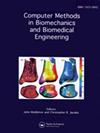Effect of foot-shaped bionic shoes on ground reaction forces and foot stress at various running speeds.
IF 1.7
4区 医学
Q3 COMPUTER SCIENCE, INTERDISCIPLINARY APPLICATIONS
Computer Methods in Biomechanics and Biomedical Engineering
Pub Date : 2025-04-15
DOI:10.1080/10255842.2025.2490139
引用次数: 0
Abstract
This study examined ground reaction forces(GRFs) and bone stress differences between bionic running shoes (with foot-mimicking soles) and traditional shoes during running.Sixteen experienced male runners ran at 10, 12, and 14 km/h in both shoe types. Two-way ANOVA and SPM1d showed that bionic shoes had significantly lower peak propulsive but higher peak braking forces than traditional shoes.Bionic shoes also exhibited lower vertical forces in early stance and altered anterior-posterior forces patterns in late stance; finite element analysis indicated lower metatarsal stress in the bionic midsoles. These findings provide insights for designing footwear to prevent running injuries.
仿脚鞋对不同跑步速度下地面反作用力和足部应力的影响。
这项研究检测了仿生跑鞋(仿脚鞋底)和传统跑鞋在跑步过程中的地面反作用力(GRFs)和骨应力的差异。16名经验丰富的男性跑步者穿着两种鞋分别以每小时10、12和14公里的速度跑步。双向方差分析和SPM1d结果表明,仿生鞋的峰值推进力明显低于传统鞋,而峰值制动力明显高于传统鞋。仿生鞋在站立早期也表现出较低的垂直力,并且在站立后期改变了前后力模式;有限元分析表明,仿生中底的跖骨应力较低。这些发现为设计防止跑步损伤的鞋类提供了见解。
本文章由计算机程序翻译,如有差异,请以英文原文为准。
求助全文
约1分钟内获得全文
求助全文
来源期刊
CiteScore
4.10
自引率
6.20%
发文量
179
审稿时长
4-8 weeks
期刊介绍:
The primary aims of Computer Methods in Biomechanics and Biomedical Engineering are to provide a means of communicating the advances being made in the areas of biomechanics and biomedical engineering and to stimulate interest in the continually emerging computer based technologies which are being applied in these multidisciplinary subjects. Computer Methods in Biomechanics and Biomedical Engineering will also provide a focus for the importance of integrating the disciplines of engineering with medical technology and clinical expertise. Such integration will have a major impact on health care in the future.

 求助内容:
求助内容: 应助结果提醒方式:
应助结果提醒方式:


